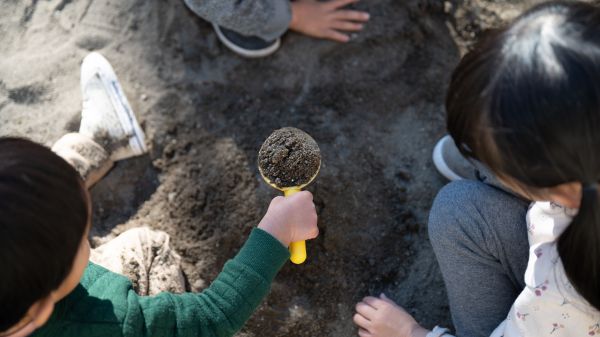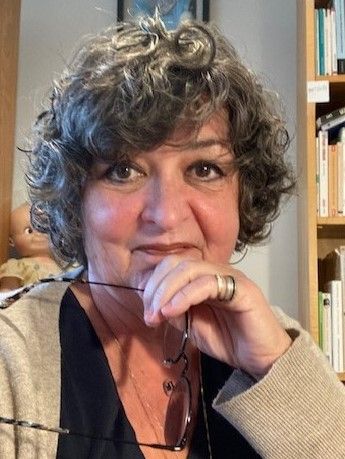Locking Eyes, Sounds, Time and Group Management in Early Childhood

Teaching about the environment in early childhood education using general abilities was the subject of my last blog. Knowledge about the general abilities of babies, two-, three-, four- and five-year-olds—like "sliding their gaze towards an adult, locking into it, and letting it pilot their own gaze" [1]—can be very useful when planning nature activities with young children. Knowledge of their general abilities, as well as the experience of their limitations, can make all the difference in group management. The ability of locking eyes takes practice, practice, practice! The more it is repeated the more successful communication will be.
Receptivity to sounds is another ability that can well serve educators and teachers.
Young children can readily learn sound cues and their meanings, like "HOHOOOO," "TATATA," or "OUPS"! When calling their attention, gathering them up, or requesting speedy actions, sounds instead of sentences are far more efficient. "DING DING DING" can identify an upcoming moment like snack time and trigger the action of getting in line. "TCHOO TCHOOOO" can be recognized as a signal that the line is moving forward, drawing young children into the game. "OH" can indicate surprise and "SHSHSHUUUT" can communicate that listening will provide a reward. "STOP" is learned very early and can bring to a sudden halt a whole group of preschoolers. If a gesture is associated with the sound and if they are repeated in a fun way, the sequence will become a game that will be played over and over without effort. Young children educated in this way are easier to manage when going outside.
Time is necessary for young children to understand information, instructions, and notions, which are all key for successful adventures. Children’s development from birth to five years old is individualistic and personal. One cannot expect them to attribute significance and sense at the same age or at the same moment. Some children may take more time to integrate what they are told. A good observer can see in their eyes when and if they did so. This implies that preparation for an outing must be done using a slower pace than for older children. Experienced educators and teachers will tell you that announcing an outdoor activity an hour in advance is both wise and efficient so that the inattentive or dreamy child are not caught off guard.
It takes time and energy for young children to listen, understand, and spring into action.
Hubert Montagner [2] explains that young children manage sounds, words, and sentences one after the other and then, they must position themselves towards the information, instruction, or notion. Looking at them, you can see them thinking.
Tackling Peter’s Object of Interest
That morning, the sun was shining, and all was nice and quiet. Our group of children was composed of one five-year-old, two four-year-olds, two three-year-olds, and three two-year-olds.
After snack time we all decided that going outside into the play area was the thing to do. We fetched our hats and water bottles and rubbed on our solar cream. All the children got in line and prepared to march past the door, up the staircase, across the lawn, down the garden steps, and into the play area as they had done so many times before. As they pushed the gate open, the older children ran to grab their favorite toy or investigate some equipment as we, the educators, held the hands of the younger children closing the gate behind us.
As we made it to the center of the play area, that’s when I saw Peter, three years old, sitting in the middle of the large sandbox holding something in his hand. He looked at it with much interest as he was opening his mouth.
“STOP!” I shouted as I lifted my index finger in a forbidding manner. He froze, mouth opened, as I made my way towards him, my eyes riveted on his. I could see his surprised reaction to the loud sound I had just uttered. There was also a little disappointment as the pleasure at hand was about to be spoiled. His eyes slowly slid towards the brown object as my hand landed on it, gently holding it up for inspection.
“HAHAHA!” I said. “OH MY!” I added as I realized that it was some animal dropping that had escaped the morning inspection of the play area. I threw it away in disgust and proceeded to rake the sandbox quickly to make sure it was free of other surprises. Peter just sat there totally confused, observing me, while I looked urgently for more of what I had just thrown away. When I was finished, I called for immediate hand washing using soapy wipes and running water.
Locking eyes, sounds, and gestures as cues, and time to manage information, instructions, and notions are strategies and tools used in tandem with young children’s abilities and limitations. Efficient communication is of the essence as educators and teachers encourage young children to play outside and explore their environment. And yes, of course, preparation, readiness, and vigilance are also in order!
If you liked this blog or have any questions, please write to me: Suzanne.major@umontreal.ca
Works Cited:
[1] Montagner, H. (2003: 45). L’attachement. Des liens pour grandir plus libre, L’Harmattan, 207 pages.
[2] Idem (2003: 47).

About the Writer
Suzanne Major is an anthropologist and early childhood educator. She received her Ph. D. in 2015, with mention of excellence, in Anthropology of Early Childhood Education from the University of Montreal, Quebec, Canada. She also has a master’s degree in Child Studies which was obtained in 2004 at Concordia University, in Montreal, Canada. She has worked 12 years as Director for the Early Childhood Studies Program of the University of Montreal’s Faculty of Permanent Education. She has been a teacher in the program for 19 years. Suzanne is also an eePRO Moderator for the Early Childhood EE Group.
